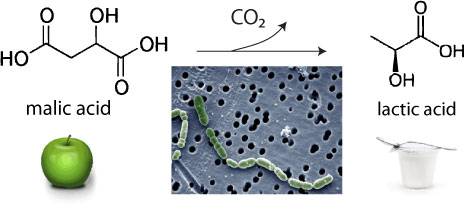Waiter ... There are Magic Crystals in my Wine!
Oh So Sorry ... How tartaric of us.
Have you ever observed these crystals in your glass?
Or attached to your cork?
Do you know they are one sign
of a very good wine?
"But how can that be, monsieur?"
you are perhaps asking.
And you thought it was just a Grape? A typical bottle of red wine is composed of Water (70-85%), Alcohol (11-16%), and "other components" (15-19%) -- magical acids and tannins and pigments -- which are what really make wine taste like wine and not alcoholic water.
This is the Culprit! Two of the magical "other components" in wine are tartaric acid and potassium -- both found naturally in grapes -- but under the proper cold conditions (like storing a bottle of wine properly around 55 degrees), they can come together to form a white (pigments in red wine turn it red) crystal called ... potassium bitartrate! Or, more simply ...
Cream of Tartar? Yes, potassium bitartrate is the same stuff you've had up in your spice rack for 12 years without a clue as to what to do with it. What is this stuff anyway?
Satori Swirls? Well, apparently bakers use it
to put a little more oomph
in their cream pies and meringues.
It's kind of like Viagra for egg whites.
Back to Our Story. A quality red wine is more likely to have these tartrates because the winery wants to maintain all the flavor from all the natural elements in the grapes ... instead of removing essential flavor ingredients that may or may not (it's very unpredictable!) crystallize after the wine is bottled.
Freeze, baby, Freeze. Many wineries, however, chill new wines to just above the freezing point; the crystals form and settle to the bottom of the tank. The wine is then racked or filtered while still cold to remove every bit of cream of tartar crystal. This process -- called cold stabilization -- is fine for white wines since it does not affect their taste. But for red wines, chilling may cause pigments, tannins, and other magical components of wine structure or "body" or flavor to drop out with the C of T. That's why T. says Satori chooses to not cold stabilize or super-micro-filter its wines. It's a "baby out with the bathwater" kind of thing.
Don't Worry. If you drink lesser-quality wines,
tartrates are never an issue ...
there's not enough good acids in plonk
to precipitate into
"flavor savers," as T. calls them.
Does it Hurt? Nope.
Odorless, tasteless, harmless. Just a bit gritty.
As noted author, Hugh Johnson, puts it in "Wine."
“It is remarkably hard to convince people (especially in the U.S.) that sediment in wine is harmless and natural and untampered with. If wine has been pasteurized, put through very fine filters or otherwise denatured, IT IS POSSIBLE TO AVOID SEDIMENT.
But it is no longer natural wine:
it seems too high a price to pay to avoid
the chance of a speck (on the cork) or
in the bottom of the bottle.”
Decant, baby, Decant. But if you like good wine ...
and suspect the presence of magic crystals therein ...
and prefer to leave them in the bottle ...
and not in your glass or mouth ...
just put the bottle upright for a few hours
so the crystals can settle ...
then pour the wine carefully
into decanter or glass
leaving the red diamonds
in the last few drops.
(Or you can use them in your next red meringues.)
satori
.













